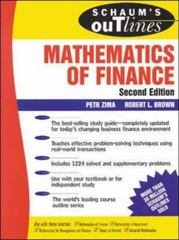Question
Classic Pen Company is a producer of ballpoint pens. The company has an administrative office that is comprised of the executive staff, accounting, purchasing, and
Classic Pen Company is a producer of ballpoint pens. The company has an administrative office that is comprised of the executive staff, accounting, purchasing, and the information technology staff. The President leads the executive staff. Accounting consists of a Controller and several accounting clerks, two of whom serve as order processors. Orders are processed by the clerks and sent to manufacturing for scheduling and production. Order processors (2 of them) make $8 per hour and generally work a 40 hour week. Purchasing is a one-man operation. The purchasing agent makes $45,000 per year. He is responsible for purchasing everything the company buys, which includes raw materials, computers, office supplies, and any other miscellaneous items approved for purchase. The company also maintains a sales staff and a manufacturing facility, in which they manufacture the pens they market and sell. The sales staff consists of six outside sales representatives, each assigned a specific territory. The salesmen visit customers and take orders, which they transmit to the company at the end of each day. The salesmen are paid a base salary of $35,000 per year plus a 2% commission on orders. They drive company cars and use company-provided computers and phones. The manufacturing facility employs a scheduler/dispatcher who schedules production and delivery of finished orders to customers. His name is Ted and he makes $10 per hour. He spends approximately 50% of his time dispatching and the rest of the time scheduling and tracking. Once he finalizes the schedule, he coordinates with purchasing to ensure that the right kind and amount of materials are ordered to meet production needs. Ted typically works a 50 hour week. If production increases beyond current levels, Ted will need some additional help to keep up with the volume. If this were to occur, Ted would not work overtime as the additional demand would be 2 met by the new employee. If demand falls, Ted would still work a 40 hour week as it always necessary to have an employee onsite for dispatching/scheduling emergencies. Ted takes two weeks vacation per year, which is paid at his straight-time rate. The manufacturing operation is supervised by Jeffrey Donald, who has been employed by the company for five years and earns a salary of $60,000 per year plus bonus. He reports to the President. Jeffrey supervises all the direct laborers and the mechanics. The mechanics are responsible for maintaining the equipment and performing changeovers when necessary to process different colored pens. This involves preparing and mixing the ink. There are two mechanics. They spend about 40% of their time on changeovers and the rest of equipment maintenance. They make $14 per hour. The second mechanic was hired when production exceeded 50,000 pens, which equates to 5,000 machine hours. At that time, additional equipment was also added to increase capacity to 10,000 machine hours. The company leases its manufacturing facility for $5,000 per month and pay insurance of $2,000 per month on the building and workmans compensation insurance of $3,000 per month. Of the $3,000 workmans compensation cost, $2,000 is related to the laborers and the remaining $1,000 to the mechanics. The company typically manufactures 90,000 pens per year (50,000 blue and 40,000 black). Material cost per pen averages $.50 per pen and it takes .2 hours of direct labor at $8 per hour and .1 hour of machine time to produce a pen. The company schedules 50 production runs of each color at their current levels of production. The setup time (in hours) for blue pens is 4 hours per run and the setup time for black pens is 1 hour per run. All estimates given above are based on this production volume. The company has a maximum capacity in their current facility of 10,000 machine hours, which equates to production volumes of 100,000 pens.
1. Explain what is meant by a cost driver. Identify an appropriate cost driver for analyzing the various costs of the manufacturing facility. Justify your answer for each.
2. Explain what is meant by relevant range. Based on your chosen activity measure above, identify the current relevant range of activity for the manufacturing facility. Justify your answer. Explain why the consideration of relevant range is significant to the analysis here.
3. Cost Analysis: You may find it useful to organize costs in the table below. a. Identify and briefly describe each cost associated with the manufacturing facility. b. Classify each cost associated with the manufacturing facility as fixed, variable, or mixed within the relevant range of activity you identified above. Justify your classifications. Would your classifications change if production activity moved outside the relevant range of activity you identified above? Explain. c. Classify each cost associated as direct or indirect assuming that the cost object of interest is the manufacturing facility as a whole. Justify your classifications. Would your classifications change if you were to assume that the cost object of interest was an individual pen processed? Explain.
4. Explain what is meant by a unit cost. Calculate the unit cost of a pen (assume no bonuses are paid). Is the unit cost of each pen different or the same? Show all calculations and explain your reasoning.
5/Suppose you are asked to estimate the cost for the manufacturing facility if production increases to 140,000 pens. Could you use the unit cost to estimate the cost? Why or why not?
Step by Step Solution
There are 3 Steps involved in it
Step: 1

Get Instant Access to Expert-Tailored Solutions
See step-by-step solutions with expert insights and AI powered tools for academic success
Step: 2

Step: 3

Ace Your Homework with AI
Get the answers you need in no time with our AI-driven, step-by-step assistance
Get Started


